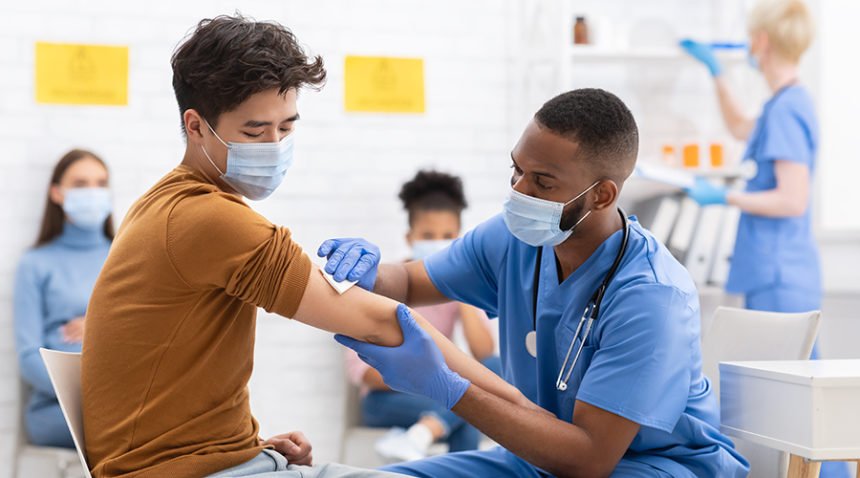Three COVID-19 vaccines made by Moderna, Pfizer and Johnson & Johnson are now available, and millions of people have been vaccinated. However, millions more await their turn. With there being three options, you may wonder: Does it matter which vaccine you get?
Healthcare experts agree that the answer is no. They recommend you get whichever vaccine is offered when you are eligible.
“The goal of any vaccine is to keep you from getting very sick and needing to go to the hospital or dying. All three COVID-19 vaccines have been tested and have proven they achieve this goal,” says UNC Health infectious diseases specialist David A. Wohl, MD. “In clinical research studies, all the vaccines were 100 percent effective in preventing hospitalizations and death.”
Because vaccine supplies are scarce, you may not be offered a choice of vaccine type. The vaccine available at the location where you are being vaccinated is the one you’ll receive. Here’s what you need to know about the vaccines.
The COVID-19 Vaccines Are More Alike Than Different
The three available vaccines are similar in the following ways:
- They are safe. The Food and Drug Administration (FDA) released all three vaccines for emergency use authorization (EUA). The vaccines have been through every stage of clinical trials that would normally take place. It is very important to understand that it is not possible to get a vaccine into humans without taking all the necessary steps. The FDA will only allow an EUA if the expected benefits outweigh the potential risks.
- They prevent hospitalization and death. Clinical trial data for all three vaccines show that they were 100 percent effective in preventing virus-related deaths and hospitalizations.
- They do not contain COVID-19. None of the vaccines contain the virus that causes COVID-19, and they cannot cause infection. The Moderna and Pfizer vaccines use messenger RNA, or mRNA, to get your immune system to launch a response to what it thinks is the COVID-19 virus and thus trains your body to make antibodies to fight the virus. The Johnson & Johnson vaccine uses a weakened common cold virus, called an adenovirus, to get the message inside the body so that the body can see it and respond. It’s important to know: The adenovirus has been genetically modified so that it cannot duplicate or give you a cold.
- The most common side effect of all three vaccines is soreness at the injection site. It is normal to experience mild-to-moderate side effects after receiving a vaccine, whether the vaccine is for COVID-19, the flu, or is another type of vaccine. Mild tenderness, swelling and/or soreness in your arm where you received your shot are common for these three vaccines. Other symptoms may include feeling tired and achy, a slight fever or a mild headache. Side effects usually last only a day or two.
One Shot vs. Two
The Johnson & Johnson vaccine requires only one shot as opposed to the Pfizer and Moderna vaccines, which require two doses.
That could make a difference when it comes to getting as many people vaccinated as possible, as it’s easier to administer because you only have to do it once. It’s also easier to store and ship. This means the vaccine can be better distributed in areas that may not have the resources or infrastructure to house the vaccines that require super-cold storage.
“You get one shot. You don’t have to come back for the second, which is really convenient for a lot of people,” Dr. Wohl says.
That said, don’t wait for the Johnson & Johnson shot if a Moderna or Pfizer shot is ready for you. Just be sure you return for your second appointment to maximize your protection.
Understanding the Clinical Trial Data
There was a lot of buzz early on about how the vaccines compared with one another based on clinical trial data. You may have heard that the Johnson & Johnson vaccine was only 66 percent effective in preventing people from becoming sick with COVID-19, while the other two vaccines were more than 90 percent effective. But a closer look at the data tells a more complex story.
“We’re not comparing apples to apples. Where they’ve been studied is different, the type of people who are enrolled is different and the time period that they enrolled patients is different,” Dr. Wohl says. “The Johnson & Johnson vaccine enrolled people in parts of Africa where a new variant is highly prevalent, where more than 90 percent of the people who are getting infected nowadays get a variant we really don’t have a lot of data on with the Moderna and Pfizer vaccines.”
The Johnson & Johnson vaccine was tested later in the pandemic, in different countries with different sets of people when different versions of the virus were circulating. It had varying levels of efficacy depending on the country, which is why it was 72 percent effective in the United States where the variants were not as prominent but 66 percent effective overall in the large trial, which included Brazil and South Africa, where there were new variants.
It is important to note that the Johnson & Johnson vaccine was 85 percent protective against severe COVID-19 illness.
All three vaccines protect against the variant of the virus that originated in Great Britain, and the Johnson & Johnson vaccine appears to provide some protection against new variants from Brazil and South Africa as well. Lab tests predict that the Pfizer and Moderna vaccines protect against new variants of the virus, but further research is underway.
Again, most importantly: Each available vaccine will protect you from hospitalization and death due to COVID-19.
Visit yourshot.org for the latest information on the COVID-19 vaccines.

